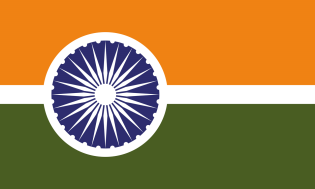Republic of India
| |||||
 | |||||
|---|---|---|---|---|---|
| National Flag | |||||
| Astrography | |||||
|
Area |
| ||||
|
Capital |
|||||
| Sovereignty | |||||
|
Independence |
1957 | ||||
| Demographics | |||||
|
Demonym(s) |
Indian | ||||
|
Population |
28,492,700,000 (2285 estimate) | ||||
|
Languages |
| ||||
| Infrastructure | |||||
| Astropolitics | |||||
 | |||||
| Starmap Roundel | |||||
|
Classification |
|||||
|
LoN Status |
|||||
|
Membership(s) |
|||||
The Republic of India, commonly known as India, is a Legacy Nation comprising the spinward edge of the Indian Arm. It is the second-most populous nation and the largest democracy in the Orion Arm. After its establishment as a federal republic in 1957, after periods of societal upheaval caused by the Evacuation Effort, India's rapidly developing major economy and increasing presence in diplomatic affairs have established it as a Potential Superpower. It is a Great Power, a Security Council Member of the League of Nations, and a founding member of the Non-Aligned Movement.
History
Pre-First Scinfaxi War
Modern humans arrived on the Indian subcontinent on Earth from Africa no later than 53,000 BCE. Settled life emerged on the subcontinent in the western margins of the Indus river basin around 7,000 BCE, evolving gradually into the Indus Valley Civilisation of 3000 BCE. By 1200 BCE, an archaic form of Sanskrit, an Indo-European language, had diffused into India from the northwest. Its hymns recorded the dawning of Hinduism in India. India's pre-existing Dravidian languages were supplanted in the northern regions. By 400 BCE, caste had emerged within Hinduism, and Buddhism and Jainism had arisen, proclaiming social orders unlinked to heredity. Early political consolidations gave rise to the loose-knit Maurya and Gupta Empires. In South India, the Middle kingdoms exported Dravidian language scripts and religious cultures to the kingdoms of Southeast Asia.
In the early mediaeval era, Christianity, Islam, Judaism, and Zoroastrianism became established on India's southern and western coasts. Muslim armies from Central Asia intermittently overran India's northern plains. The resulting Delhi Sultanate drew northern India into the cosmopolitan networks of mediaeval Islam. In south India, the Vijayanagara Empire created a long-lasting composite Hindu culture. In the Punjab, Sikhism emerged, rejecting institutionalised religion. The Mughal Empire, in 1526, ushered in two centuries of relative peace, leaving a legacy of luminous architecture. Gradually expanding rule of the British East India Company followed, turning India into a colonial economy but consolidating its sovereignty. British Crown rule began in 1858. The rights promised to Indians were granted slowly, but technological changes were introduced, and modern ideas of education and public life took root. A pioneering and influential nationalist movement emerged, becoming a major factor toward ending British rule.
The Cold War
The Republic of India is one of three Great Powers within the Local Supercluster, along with the United Centauri Republic and the Federative Republic of Brazil. Its role within Orion astropolitics is defined by its strategic position bordering major translight routes, its emerging status as a major power, and a growing rivalry with Brazil. Its predominant role within the Non-Aligned Movement gives it a great interstellar reach, amplified soft power.
Federative Republic of Brazil - Republic of India Tensions
As a part of an ongoing rivalry between the Federative Republic of Brazil and the Republic of India, a series of high-profile freedom of navigation exercises have been conducted by the competing nations in one another's IDIZs.
Both Brazil and India have imposed broad tariffs targeting each other's exports in their ongoing competition to extend their rival IDIZs and free trade zones.
Mandhatri 85
The Indian Council of Astrobiology, partnered with their British counterparts, saw hundreds of scientists embark on the Mandhatri 85 expedition in 2285 with the goal of studying the architecture and possible functions of Borehole 814.
References
- "Brazil Retaliates Within Hours After India Targets Core Export Sectors". Champlain Group.
- "Joint Indian-British Expedition Mandhatri 85 Enters "Gateway To Hell" On Kurugallu". Champlain Group.
- "IDIZ Incursions Heighten India-Brazil Tensions". Champlain Group.
- "Indian Naval Armada Sparks Diplomatic Row In Bolivar Sea Exercise". Champlain Group.
- "Indian Rifleman". Champlain Group.
| Great Powers of the Orion Arm |
|---|